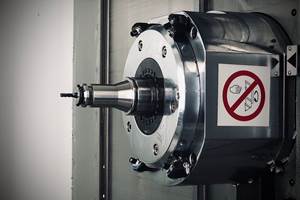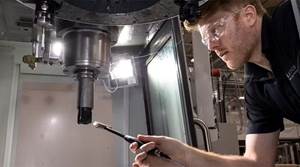Single System Offers Multiple Finishing Processes For Small Parts
An electrochemical finishing technology geared toward small workpieces cleans, deburrs, passivates, polishes and stress relieves workpieces all at once.
Share





Accurate machining is only one piece of the manufacturing puzzle. Machined components, especially those used for medical, scientific, semi-conductor and automotive applications, often require secondary finishing processes for polishing or burr removal before assembly or use. These secondary operations can be challenging for very small parts or parts with delicate features. Mechanical finishing processes have the potential to be damaging, while conventional electropolishing (EP) may not have the capability to remove large burrs. This is often why many shops will outsource this post-machining work.
Extrude Hone (Irwin, Pennsylvania), has developed a new electrochemical finishing technology that can perform five finishing processes in one operation. Geared toward small-parts finishing, the company’s CoolPulse system simultaneously cleans, deburrs, passivates, polishes and stress relieves workpieces. The non-contact system will not damage tiny features, such as thin walls. It offers advantages over traditional EP in that it uses a cool, non-fuming electrolyte solution that is easy to handle. Plus, the system’s relatively small learning curve may lead shops to consider bringing finishing work in-house, where they can have better control over delivery time, part handling and costs.
Like conventional EP, the CoolPulse process immerses workpieces in an electrolyte bath and applies a low-voltage DC charge. However, the CoolPulse process differs from EP in various ways, according to Jim Koroskenyi, managing director of Extrude Hone’s electrochemical business unit. It uses a chilled, high-resistance electrolyte solution with a near-neutral pH level. Because the solution is odorless and non-fuming, it does not require a dedicated ventilation system and is safe to handle. Its high electrical resistance makes it effective for removing burrs and peaks on workpiece surfaces. A filtration system allows the solution to retain its effectiveness over extended periods of operating time, eliminating costs for additional solution or for waste disposal.
The solution is compatible with a variety of materials, including steels, aluminum and magnesium, as well as chrome and cobalt alloys and copper-based alloys. The system accommodates different material types and workpiece sizes through adjustment of parameters such as voltage, pulse, time and temperature. Typical finishing cycle time ranges from 15 seconds for very small parts to 3 minutes for workpieces with large burrs and heavy polishing requirements. Those cycle times are the same for one or multiple parts. This is twice the speed of conventional EP, according to Mr. Koroskenyi.
While CoolPulse is optimized for burr removal, substantial surface and cleanliness improvements are natural by-products of the process. The system produces a mirror-like finish on stainless steel and bright to matte finishes on aluminum.
Mr. Koroskenyi says conventional EP can take considerable training and experience to maintain process control, which is often why shops outsource this these secondary operations. However, this works against the goal of single-part manufacturing, cellular production and minimizing part movement. The CoolPulse system is designed for installation on the shop floor, and the skill set needed to operate the system is said to be comparable to that required to operate a CNC machining center or EDM unit.
So what kind of learning curve would shops having no experience with such finishing equipment face with this system? Mr. Koroskenyi says that shops should first spend two days of theory training and three days of practical demonstration and tooling and process training. After two to three weeks, shops should be able to master the technology for one class of parts. Two to three months later, shops are likely to possess sufficient understanding to finish virtually any type of part.
Related Content
High-Feed Machining Dominates Cutting Tool Event
At its New Product Rollout, Ingersoll showcased a number of options for high-feed machining, demonstrating the strategy’s growing footprint in the industry.
Read MoreHow to Troubleshoot Issues With Tool Life
Diagnosing when a tool is failing is important because it sets an expectation and a benchmark for improvements. Finding out why gives us a clue for how to fix it.
Read MoreFinding the Right Tools for a Turning Shop
Xcelicut is a startup shop that has grown thanks to the right machines, cutting tools, grants and other resources.
Read MoreHow to Mitigate Chatter to Boost Machining Rates
There are usually better solutions to chatter than just reducing the feed rate. Through vibration analysis, the chatter problem can be solved, enabling much higher metal removal rates, better quality and longer tool life.
Read MoreRead Next
AMRs Are Moving Into Manufacturing: 4 Considerations for Implementation
AMRs can provide a flexible, easy-to-use automation platform so long as manufacturers choose a suitable task and prepare their facilities.
Read MoreLast Chance! 2025 Top Shops Benchmarking Survey Still Open Through April 30
Don’t miss out! 91ÊÓƵÍøÕ¾ÎÛ's Top Shops Benchmarking Survey is still open — but not for long. This is your last chance to a receive free, customized benchmarking report that includes actionable feedback across several shopfloor and business metrics.
Read MoreMachine Shop MBA
Making Chips and 91ÊÓƵÍøÕ¾ÎÛ are teaming up for a new podcast series called Machine Shop MBA—designed to help manufacturers measure their success against the industry’s best. Through the lens of the Top Shops benchmarking program, the series explores the KPIs that set high-performing shops apart, from machine utilization and first-pass yield to employee engagement and revenue per employee.
Read More






















